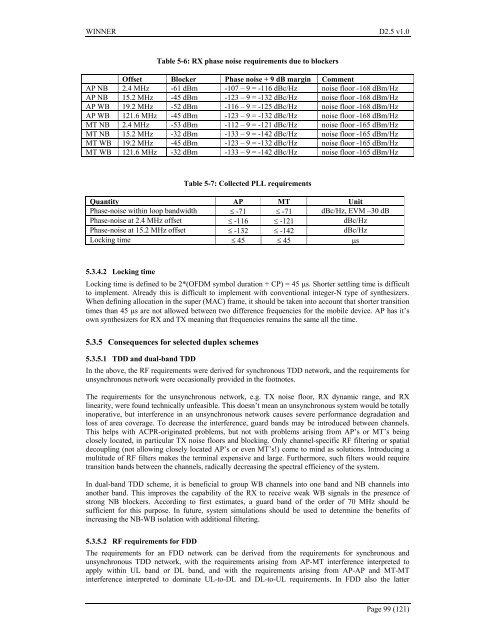IST-2003-507581 WINNER D2.5 v1.0 Duplex ... - Celtic-Plus
IST-2003-507581 WINNER D2.5 v1.0 Duplex ... - Celtic-Plus
IST-2003-507581 WINNER D2.5 v1.0 Duplex ... - Celtic-Plus
- No tags were found...
You also want an ePaper? Increase the reach of your titles
YUMPU automatically turns print PDFs into web optimized ePapers that Google loves.
<strong>WINNER</strong> <strong>D2.5</strong> <strong>v1.0</strong>Table 5-6: RX phase noise requirements due to blockersOffset Blocker Phase noise + 9 dB margin CommentAP NB 2.4 MHz -61 dBm -107 – 9 = -116 dBc/Hz noise floor -168 dBm/HzAP NB 15.2 MHz -45 dBm -123 – 9 = -132 dBc/Hz noise floor -168 dBm/HzAP WB 19.2 MHz -52 dBm -116 – 9 = -125 dBc/Hz noise floor -168 dBm/HzAP WB 121.6 MHz -45 dBm -123 – 9 = -132 dBc/Hz noise floor -168 dBm/HzMT NB 2.4 MHz -53 dBm -112 – 9 = -121 dBc/Hz noise floor -165 dBm/HzMT NB 15.2 MHz -32 dBm -133 – 9 = -142 dBc/Hz noise floor -165 dBm/HzMT WB 19.2 MHz -45 dBm -123 – 9 = -132 dBc/Hz noise floor -165 dBm/HzMT WB 121.6 MHz -32 dBm -133 – 9 = -142 dBc/Hz noise floor -165 dBm/HzTable 5-7: Collected PLL requirementsQuantity AP MT UnitPhase-noise within loop bandwidth ≤ -71 ≤ -71 dBc/Hz, EVM –30 dBPhase-noise at 2.4 MHz offset ≤ -116 ≤ -121 dBc/HzPhase-noise at 15.2 MHz offset ≤ -132 ≤ -142 dBc/HzLocking time ≤ 45 ≤ 45 µs5.3.4.2 Locking timeLocking time is defined to be 2*(OFDM symbol duration + CP) = 45 µs. Shorter settling time is difficultto implement. Already this is difficult to implement with conventional integer-N type of synthesizers.When defining allocation in the super (MAC) frame, it should be taken into account that shorter transitiontimes than 45 µs are not allowed between two difference frequencies for the mobile device. AP has it’sown synthesizers for RX and TX meaning that frequencies remains the same all the time.5.3.5 Consequences for selected duplex schemes5.3.5.1 TDD and dual-band TDDIn the above, the RF requirements were derived for synchronous TDD network, and the requirements forunsynchronous network were occasionally provided in the footnotes.The requirements for the unsynchronous network, e.g. TX noise floor, RX dynamic range, and RXlinearity, were found technically unfeasible. This doesn’t mean an unsynchronous system would be totallyinoperative, but interference in an unsynchronous network causes severe performance degradation andloss of area coverage. To decrease the interference, guard bands may be introduced between channels.This helps with ACPR-originated problems, but not with problems arising from AP’s or MT’s beingclosely located, in particular TX noise floors and blocking. Only channel-specific RF filtering or spatialdecoupling (not allowing closely located AP’s or even MT’s!) come to mind as solutions. Introducing amultitude of RF filters makes the terminal expensive and large. Furthermore, such filters would requiretransition bands between the channels, radically decreasing the spectral efficiency of the system.In dual-band TDD scheme, it is beneficial to group WB channels into one band and NB channels intoanother band. This improves the capability of the RX to receive weak WB signals in the presence ofstrong NB blockers. According to first estimates, a guard band of the order of 70 MHz should besufficient for this purpose. In future, system simulations should be used to determine the benefits ofincreasing the NB-WB isolation with additional filtering.5.3.5.2 RF requirements for FDDThe requirements for an FDD network can be derived from the requirements for synchronous andunsynchronous TDD network, with the requirements arising from AP-MT interference interpreted toapply within UL band or DL band, and with the requirements arising from AP-AP and MT-MTinterference interpreted to dominate UL-to-DL and DL-to-UL requirements. In FDD also the latterPage 99 (121)
















